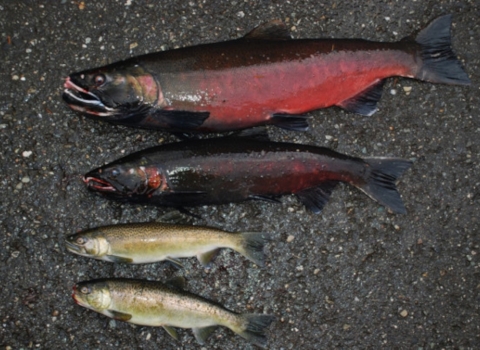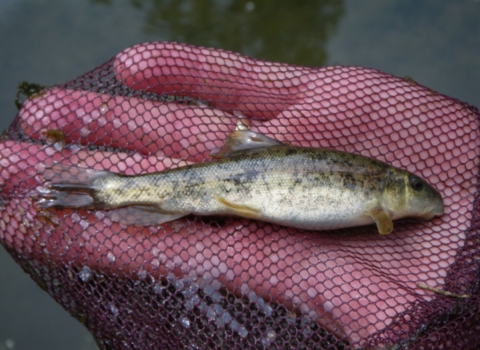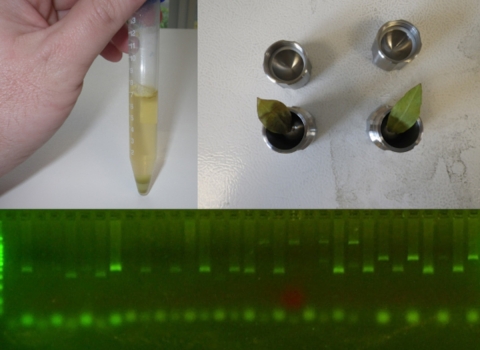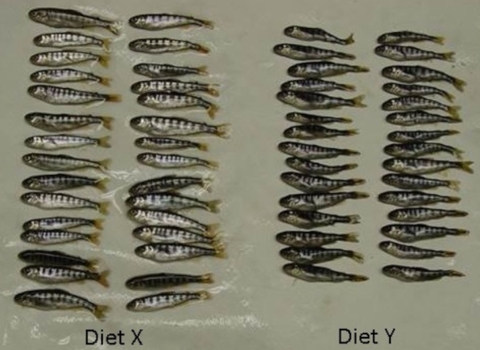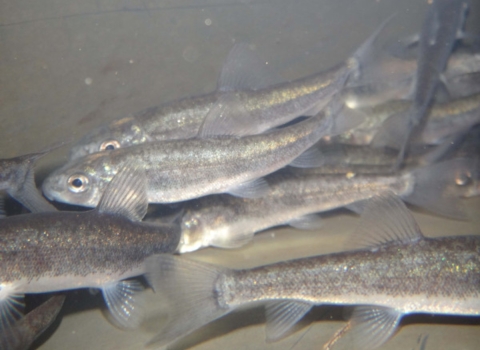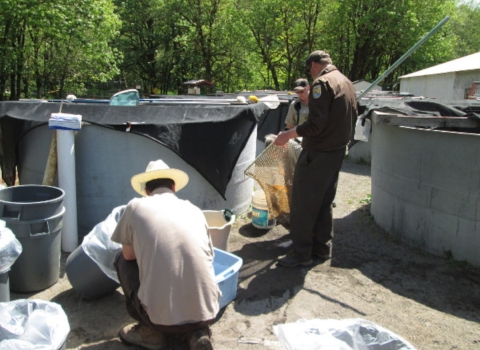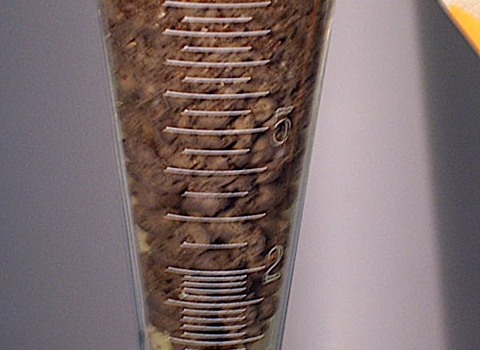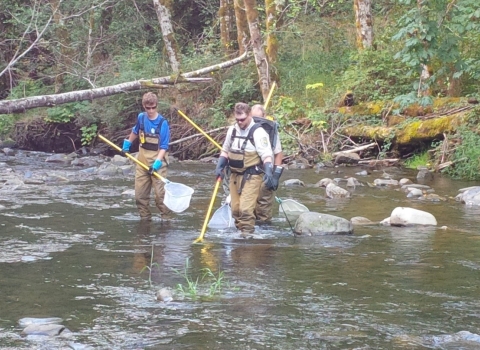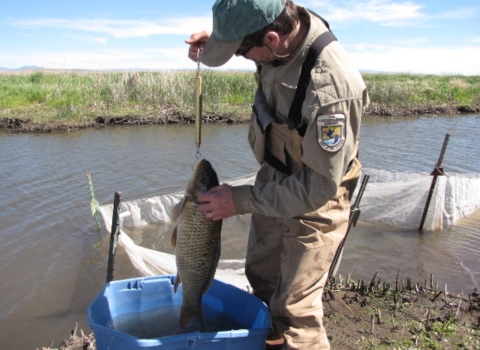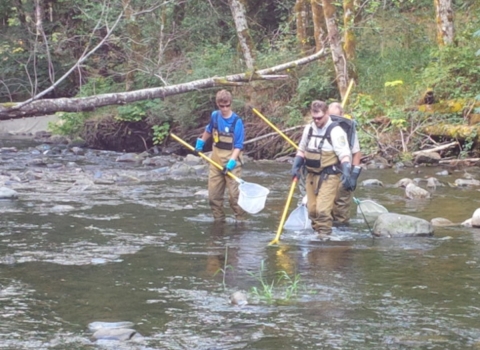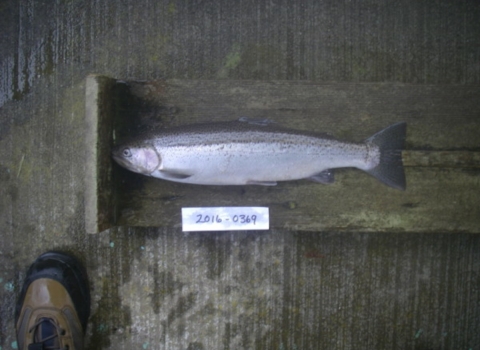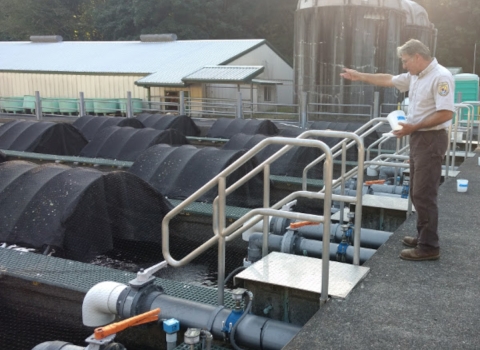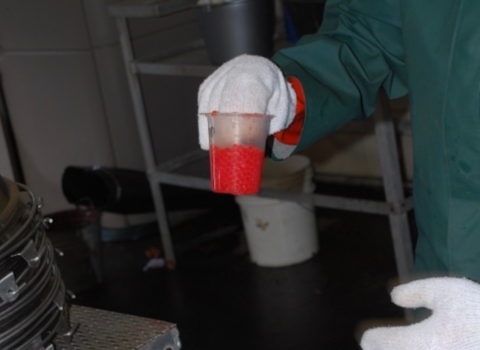Projects and Research
Here's a link to our Library Collection to view all projects and research.
What species is this? Or, what population did this individual come from? These types of questions can be answered by comparing DNA from an individual in question to a database of reference samples. In some situations answering these questions is critical for making urgent management decisions, in which case, we perform our "rapid-response" protocol. For example, in California, we use genetics...
Early questions in this category mostly concerned culture practices which introduced artificial selection, such as selectively spawning the largest fish or the earliest-returning fish, or mixing the milt of several males prior to fertilization. Hatchery managers must also make a large number of decisions about the spawning process which may impact genetic diversity, including numbers and...
How divergent is this population? Where are the boundaries between populations of this species? These types of questions are often asked in the context of listing, de-listing or development of recovery plans for threatened or endangered species. However, understanding population structure and divergence has relevance for informing management of any species. In order to preserve genetic...
One of our ultimate goals as an agency is to maintain viable populations of fish and wildlife that have a high likelihood of persisting into the future. Genetic data play a critical role, for things such as inbreeding, loss of genetic diversity, hybridization, and a number of breeding individuals can impact the prospects of a population. A common request is to assess genetic diversity, which...
As employees of the U.S. Fish and Wildlife Service, our most important function is providing technical support for our regional and field offices. We are a resource for our offices and partners to provide expertise in the application and interpretation of genetic techniques. We assist managers with interpreting the results of genetic studies conducted by external partners, such as those...
Since the 1960s, Abernathy has had a Fish Feed Quality Control (FFQC) program for the hatcheries in the Pacific and Pacific Southwest Regions. Inspections are done at the feed mills when open formula feeds are made and if there is a feed problem at a hatchery, that feed is analyzed at Abernathy. Otherwise, feeds are sampled quarterly at all the Pacific and Southwest Pacific Regions National...
The U.S. Fish and Wildlife Service has responsibility for threatened and endangered aquatic species in addition to the species they raise for mitigation and recovery in conservation hatcheries. These species, due to habitat degradation and loss, may need to be held in refugia. The success of such a program will require the determination of the nutritional needs of this species. For diet...
Feeding fish in NFHs can be challenging. The commercial feeds that are available are high energy ones and are formulated for rapid growth, which is not necessarily desired in a conservation hatchery. Questions arise from the hatcheries about feed rates, methods and protocols. The answers they need will enable them to produce competent smolts leaving their hatcheries. Each facility is different...
With the volatile commodities market and the actual scarcity of some ingredients such as fish meal and oil, feeds using alternative proteins and oils need to be tested. Feeds that have already been developed in the commercial feed industry may not meet the needs of FWS. Fish nutrition research at the Abernathy Fish Tech Center addresses the suitability of the alternative proteins and oils in...
The Environmental Protection Agency has prepared guidelines for effluent discharges from commercial, federal, state, tribal, and private hatchery facilities. Phosphorous is generally the first limiting nutrient in fresh water for aquatic plant growth. Fish hatchery water effluent is a source of phosphorous and solids derived from uneaten, undigested feed and metabolic losses. With the use of...
As a way to mitigate for fish losses from habitat destruction, fish passage barriers, and over-harvest, millions of Pacific salmon and steelhead are reared in and released from hatcheries in the Columbia River basin and the west coast of North America. Unfortunately, Pacific salmon reared in hatcheries can become different - for example genetically or behaviorally - relative to their wild fish...
In addition to hatcheries, habitat restoration is also used as a way to mitigate for human-caused habitat destruction. Currently, great effort and cost is spent on restoring streams to a more historically natural state in hopes of increasing salmonid survival and abundance. One of the most widely used techniques is to add large woody debris to the stream channel to increase sediment retention...
The introduction and spread of non-native aquatic species can have profound consequences for aquatic habitats and species. From hybridization between trout species to ecosystem-level changes caused by zebra and quagga mussels, addressing threats and impacts from non-native species are a challenge to natural resource managers. In many cases, it is impossible to completely remove a non-native...
The most direct effect of climate change on fish populations is expected to be from changes to water temperature and water availability, which can affect individual growth, survival, and movement. To inform how changes in temperature and stream flow might affect fish populations of interest, we have built probabilistic models and modeling frameworks that use future climate data as inputs and...
Natural resource managers often face hard decisions with uncertain outcomes. Common questions we have encountered include: What is the best way to conserve fish populations in the presence of dams when other threats are also present? or Will removing this migration barrier to benefit native fish let non-native fish invade? In these cases, empirical data may not be available or the question may...
Whether electrofishing juvenile fish in a stream to obtain population estimates or cleaning hatchery raceways, our activities can stress fish. As much as possible we try to avoid stressing fish as this can have negative effects on most biological processes, including disease resistance, growth and reproduction. We can measure the degree to which an environmental condition, human activity or...
Fish biologists often need to capture and tag fish in order to monitor their behavior and movements in the wild. However, the process of capturing the animals and implanting transmitters can be stressful and alter the behavior of a fish, thereby biasing research results. By studying the physiology of a species we gain basic information that is needed to modify our research so that it has...
Analysis of tagging data has revealed that survival to adulthood of steelhead released from one state hatchery is generally 1.5 to 3 times higher than that of the same stock of steelhead released from a nearby hatchery. The mechanisms for the differences in post-release performance between fish reared in the two hatcheries are unknown. Different hatchery rearing protocols (densities, pond...
High energy diets and high feed rates used in salmon hatcheries can cause early sexual maturation in male salmon. Early maturing male salmon may stay in freshwater and spawn at an early age rather than migrate to the ocean to feed for months or years. Because of this, these fish are usually smaller than males that mature at a later age and can also negatively affect freshwater ecosystems...
Although ocean conditions are known to have a direct effect on growth and survival of salmon at sea, there is less information on the effects of ocean conditions on salmon egg quality and reproductive success. To increase our understanding of the relationship between ocean conditions and egg quality at two national fish hatcheries, Abernathy physiologists are comparing the nutrient profile of...
Freshwater mussels, benthic and filter feeding, maintain or improve water quality conditions and support diverse aquatic communities that are beneficial for salmon, lamprey and other native fish. The mussels also have cultural importance for the tribes of the Pacific Northwest in that they are first foods that are culturally significant for adornment and trade. The freshwater mussels are some...


